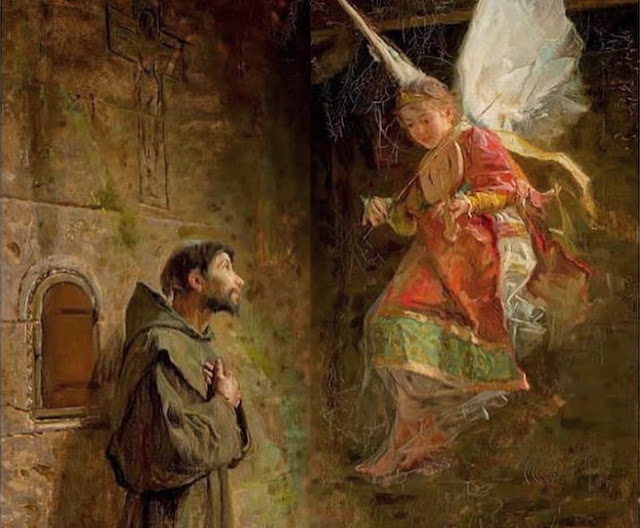Vision of Saint Francis by Menendez Pidal

Vision of Saint Francis of Assisi. Luis Menéndez Pidal, 1888. Oil on canvas
Painted in Florence in 1888, this work reflects both the artist’s deep spiritual sensitivity and the strong influence of his visit to Assisi, where the Franciscan legacy was especially alive among artists of the time. Menéndez Pidal titled it originally An Ecstasy of Saint Francis, capturing the interior moment of mystical encounter rather than a narrative scene. The subject comes from the Fioretti of Saint Francis, a devotional text that inspired many painters in the late 19th century, when the figure of Francis experienced a renewed cultural and religious admiration.
In the composition, Saint Francis stands or kneels in prayerful awe, his gaze lifted toward a heavenly vision. His face is marked by intensity and tenderness, conveying both longing and surrender. He wears the humble brown habit of the Order, and the stigmata on his hands are subtly visible, reminding us of his union with Christ. Behind him, the setting is simple and poor: a rough wooden pallet, a stone floor, and a dim, contemplative interior that evokes the saint’s hermitage and life of poverty.
Before him appears an angelic figure, softly illuminated and painted with delicate transparency. The angel seems almost weightless, surrounded by gentle light, and may be playing or offering a musical instrument, suggesting the heavenly harmony that Francis is hearing in his moment of mystical ecstasy. The brushwork here is looser and more luminous, making the angel appear almost like something seen in vision rather than in earthly form. This contrast between the solid, earthly Francis and the airy, floating angel expresses the bridge between the material and spiritual worlds.
The painting belongs to a tradition of Counter-Reformation representations of Francis in mystical union with heaven, yet Menéndez Pidal’s treatment is warmer and more intimate. His focus is not on drama, but on gentle rapture: the saint’s heart lifted toward God, accompanied by the loving presence of the angels whom Francis believed accompanied the faithful in life and in death.





Comments
Post a Comment